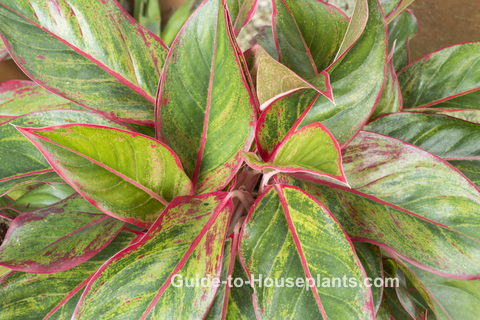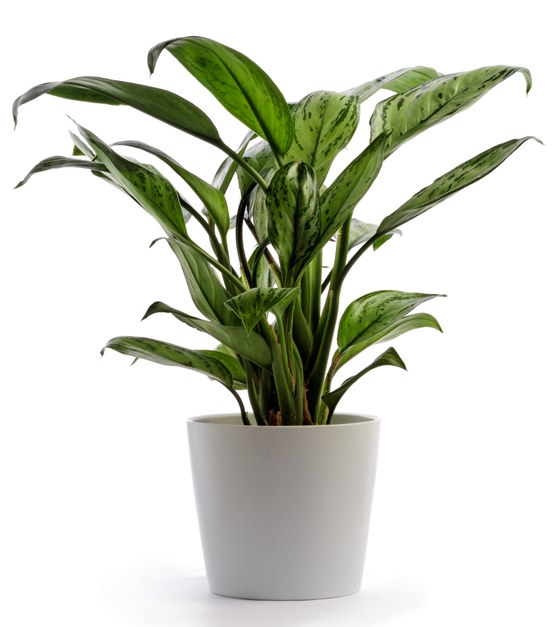Chinese Evergreen Plant – Aglaonema hybrids Pictures, Care Tips
Botanical Name: Aglaonema hybrids
Chinese Evergreen is a member of the Aroid family (Araceae), known for easy-to-please foliage house plants.
A very adaptable plant, Aglaonema tolerates low light and dry air better than most other house plants. One thing it doesn’t like is cold air. Keep your plant away from drafts and A/C vents and it’ll do just fine.
 New hybrids offer more colorful choices, such as this red-splashed variety.
New hybrids offer more colorful choices, such as this red-splashed variety.Air Cleaners
Chinese evergreens are among the best plants for removing toxins, such as formaldehyde, from tainted indoor air. As if their good looks weren’t enough, their air-cleaning abilities make them must-have house plants.
Its large, pointed, green variegated leaves are 6-10 inches (15-25 cm) long, 3-6 inches (7.5-15 cm) wide, and heavily marbled with white, cream, silver or red.
New hybrids and cultivars are developed all the time, giving us more beautiful choices than ever before. Newer hybrids of this plant grow in thick clumps, so mature plants stay compact and bushy. ‘Silver Queen’ (shown at bottom) is a compact cultivar.
Aglaonema Varieties
You have a wealth of varieties to choose from: ‘Silver Queen’ and ‘Silver Spear’ have silvery variegation that makes them stand out among group plantings. ‘Emerald Star’ has bright-green foliage speckled with creamy white. ‘Silver Bay’ is lavishly splashed with silvery green. ‘Firecracker’ is boldly mottled with fiery red. Choose the one you like, they all make eye-catching house plants.
Caring for Chinese Evergreen
Water regularly. Consistently moist soil will keep this plant happy. In fact, it can grow in water alone.
Don’t prune. All new growth is from the crown of the plant, so don’t prune it back or you’ll kill it. If it begins to look leggy, plant pothos — or some other low-light plant — in the same container to cover the bare stems.
Repot in spring when it outgrows its pot. Aglaonema likes to be slightly root-bound, so it’s a good idea to move to a pot that’s slightly larger. Use a container with drainage holes to prevent soggy soil.
Check for bugs. Scale insects can weaken Chinese Evergreen, causing its leaves to droop. Look for these tiny, brown insects on stems and the undersides of leaves. Treat any infestation right away.
Is Chinese Evergreen poisonous? Yes. Small flowers may appear in summer, followed by red berries. The berries and sap of this plant are poisonous. It’s not a good idea to keep this plant where children and pets may play with or ingest it.
Chinese Evergreen Care Tips

Origin: Subtropical forests of Southeast Asia
Height: 2-3 ft (60-90 cm)
Light: Bright, indirect light to low light. Keep it out of direct sunlight, which may cause its leaves to fade. Aglaonema grows well under fluorescent light, making it an ideal office plant.
Water: Water thoroughly, then allow surface of potting medium to dry out a bit before watering again. Keep it slightly drier in winter, when growth is slower. Don’t allow it to get so dry that its leaves wilt.
Humidity: Average indoor (around 40% relative humidity) or higher. Don’t mist, which will cause spots on its leaves. If your home is dry in the winter months, use a cool-mist room humidifier.
Temperature: Normal room temperatures 65-75°F/18-24°C. Aglaonema has no tolerance for the cold. It suffers when exposed to temps below 55°F/13°C. Cold air may cause grayish-yellow patches on its leaves. Set your plant where it won’t be exposed to cold blasts from doorways and windows, or an AC vent.
Soil: Any good-quality houseplant potting mix.
Fertilizer: Chinese Evergreen is not a big feeder. From spring through summer, feed monthly with a balanced (such as 10-10-10 npk) water-soluble houseplant fertilizer, using half the recommended amount. Do not feed in winter, when growth is slow.
Propagation: Easy to propagate by stem cuttings. Take 3-4 in (7.5-10 cm) long stem tip cuttings in spring. Dip the cut ends in water then rooting powder. Insert into sterile, moist potting mix. Keeping the plants warm and humid will improve successful propagation. Older root-bound plants can be divided.




